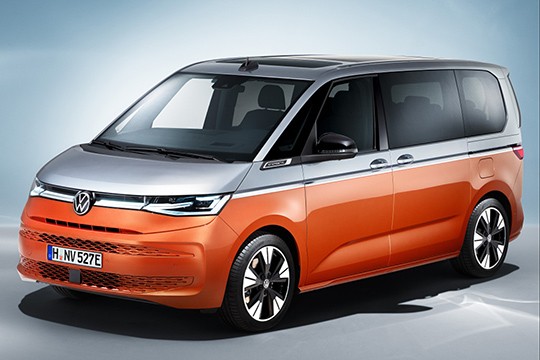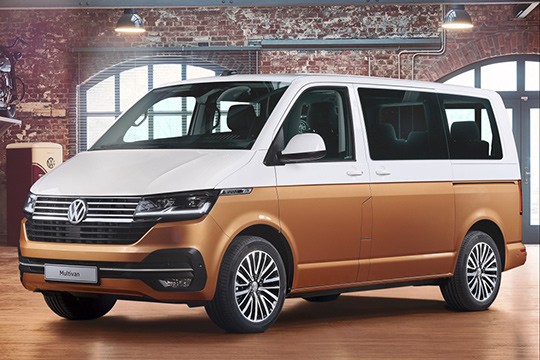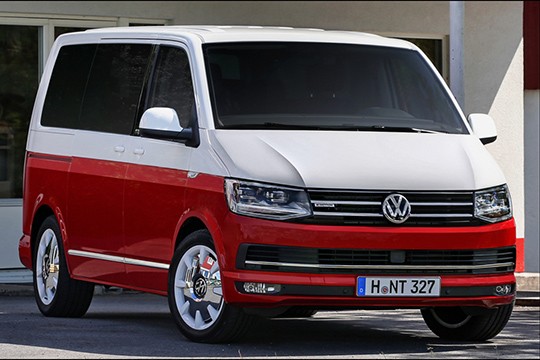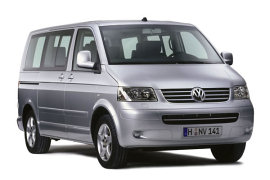VOLKSWAGEN Multivan Models/Series Timeline, Specifications & Photos
First production year: 2003
Engines: Hybrid gasoline, Gasoline, Diesel
Body style: Van
Volkswagen Commercial Vehicles introduced a new generation of the Multivan model in 2021, replacing the aging T 6.1 Caravelle lineup.
Even though it came after the facelifted version of the T6, the new generation was not named T7 on the official papers. In addition, unlike its predecessors that were built on designated utility-vehicle platforms, the 2021 Multivan was based on the MQB platform shared with many other cars produced by Volkswagen.
Since the vehicle was built as a successor to the Caravelle, it had to be comfortable and good-looking but still bear a van-like appearance. At the front, the narrow, high-mounted headlights resembled those fitted on the Golf, while the fat bumper sported a massive grille with a rhomboidal pattern. From its profile, the MPV featured wide windows that covered the upper third-part of the vehicle. Apart from the big front doors, the Multivan also received one or two sliding doors, depending on the options. Last but not least, the rear tailgate could've been electrically opened.
Inside, the Multivan could accommodate up to seven passengers on three rows of individual seats. The last row, which was previously fitted with a bench, consisted of individual places that could've been moved or removed, depending on the necessities. The middle row featured two captain seats that could rotate 180 degrees. At the front, a pair of high-mounted seats were already usual for the Multivan. These allowed their occupants to enjoy the great view offered by the wide windscreen and tall side windows. In addition, the dashboard was mounted low enough not to obstruct their sight.
Underneath the car's skin, Volkswagen installed a choice of hybrid and turbodiesel engines. In addition, a plug-in hybrid fitted with a 13kW battery pack was available.
Volkswagen Commercial vehicles introduced a facelifted version for the sixth generation of the Multivan in 2019, adding some visual and technical upgrades to the popular MPV.
Even though the company was focused on creating dependable commercial vehicles, it didn't forget to build passenger versions. In addition, these didn't have to look like LCVs with seats installed aftermarket and cut-away windows on the side panels. The result was that the facelifted version of the T6, named T6.1, looked more like an MPV without windows when sold as an LCV.
At the front, Volkswagen created a new front grille that spanned between the headlights with a sharp design and chromed details. The headlamps were also changed and sported LED daytime running lights inside them, making the vehicle look like a VIP shuttle bus. As an option, Volkswagen offered them with full LED lights. From its side, the car didn't get essential changes, but a two-tone color scheme was on the options list.
Inside, like any other Multivan, the T6.1 featured a vast amount of space for seven passengers, even in the short wheelbase version. There were two seats at the front, two in the middle row, and three at the back, on a sliding and folding bench. Ingress and egress to the vehicle were easy, thanks to the front doors and the rear sliding doors on both sides. The two captain seats from the second row could've been rotated 180 degrees so the passengers could sit face-to-face with those seated on the bench.
Under the hood, Volkswagen installed a 2.0-liter turbo-diesel engine paired with either a six-speed manual or a seven-speed automatic. Power went to the front or all corners of the car, depending on the options.
VOLKSWAGEN Multivan Bulli (T6.1) 2.0i TDI BMT 4MOTION 6MT AWD (150 HP)
VOLKSWAGEN Multivan Bulli (T6.1) 2.0i TDI BMT 4MOTION 6MT AWD (150 HP) LWB
VOLKSWAGEN Multivan Bulli (T6.1) 2.0i TDI BMT 4MOTION 7AT AWD (150 HP)
VOLKSWAGEN Multivan Bulli (T6.1) 2.0i TDI BMT 4MOTION 7AT AWD (150 HP) LWB
VOLKSWAGEN Multivan Bulli (T6.1) 2.0i TDI BMT 4MOTION 7AT AWD (204 HP) LWB
VOLKSWAGEN Multivan Bulli (T6.1) 2.0i TDI BMT 5MT FWD (110 HP)
VOLKSWAGEN Multivan Bulli (T6.1) 2.0i TDI BMT 5MT FWD (110 HP) LWB
VOLKSWAGEN Multivan Bulli (T6.1) 2.0i TDI BMT 6MT FWD (150 HP)
VOLKSWAGEN Multivan Bulli (T6.1) 2.0i TDI BMT 6MT FWD (150 HP) LWB
VOLKSWAGEN Multivan Bulli (T6.1) 2.0i TDI BMT 7AT FWD (150 HP)
VOLKSWAGEN Multivan Bulli (T6.1) 2.0i TDI BMT 7AT FWD (150 HP) LWB
VOLKSWAGEN Multivan Bulli (T6.1) 2.0i TDI BMT 7AT FWD (204 HP) LWB
Volkswagen Commercial Vehicles introduced the sixth generation of the Multivan in 2015, a nameplate that was already considered by many a benchmark in the segment.
Designed as a commercial vehicle and then adapted as a people carrier, the Multivan still shared many parts with its LCV cousin. But the automaker tried to conceal that with many features and amenities that transformed the vehicle into a friendly car built for the entire family and some friends. The 2015 model was designed with the concept of a minivan in mind, and offered unique features in its segment.
At the front, the car sported a set of headlights that resembled those installed on the Passat and Polo, with an angular look on the inner part of the headlamps. In addition, the grille received a pair of chromed slats and a fat lower bumper that sported a pair of fog lamps as an option. The automaker offered a sliding door on the passenger side, while another one on the driver's side was offered as an option. These, together with the regular front doors, made the ingress and egress to the vehicle easy for all passengers. At the back, the wide tailgate was large enough to serve as a roof during rain.
Inside, the Multivan was available in various configurations, including a seven-seat option with the middle row featuring captain seats. There were plenty of options that transformed the vehicle from a regular people carrier into a VIP shuttle. Its only downturn was the high floor, which made it somehow uncomfortable. At the front, the dashboard received a flat dashboard with an integrated infotainment system placed on the center stack. Unusually, in the "Bulli" trim, the car featured a body-colored trim on the dash.
Under the hood, Volkswagen installed a choice of gasoline and turbo-diesel engines ranging from 150 PS (148 hp) to 204 PS (201 hp) that sent their power to the front or all wheels, depending on the options.
The old Volkswagen Bus that rattled the roads to Woodstock was the minivan that started it all, and the 2003 Multivan was its fifth predecessor.
The German carmaker was already known for its LCV lineup and tried to make it to the car segment. Worth mentioning that, in 2003, Volkswagen Commercial Vehicles and Volkswagen Cars were different arms of the same body and, sometimes, they didn't follow the same paths or used the same parts. The Multivan was based on the fifth Transporter generation and was the upmarket people-carrier for the German brand.
Unlike its siblings, the Transporter, the Kombi, or the Shuttle, the Multivan was designed to compete against the Mercedes-Benz V-Class and the GMC Sonoma. It still kept the same boxy shape from the outside but with a more refined look thanks to its nicely designed headlights that resembled the ones installed on the Passat, with a V-shaped line pointing toward the VW badge. Its two-slats grille sported chromed accents to enhance that upmarket look, and the tall front bumper featured foglights at the bottom. Depending on the options, the car was available with one or two sliding doors for the rear passengers.
Inside, the Volkswagen LCV division installed high seats for seven and sliding rails for various interior equipment such as a folding table, a refrigerator, or a mobile office. Its tilting and rotating captain seats allowed the owner to use the car as a field-office. Depending on the options, the user could have transformed the vehicle into a small motorhome.
Unlike many competitors, the Multivan was available with fuel-efficiency turbo-diesel engines and all-wheel-drive systems. Moreover, its independent suspension in all corners and the automatic transmission made it a comfortable and safe vehicle fit for any occasion.



